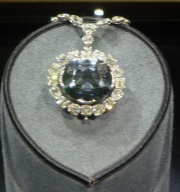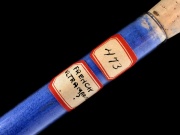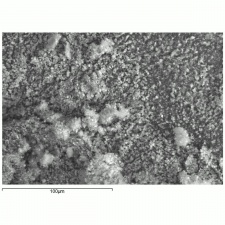Difference between revisions of "French blue"
(username removed) |
|||
| Line 2: | Line 2: | ||
== Description == | == Description == | ||
| − | 1) Commercial name used for [ | + | 1) Commercial name used for [[ultramarine blue, synthetic|synthetic ultramarine blue]] originating from the early 19th century when the pigment was first imported from France (Mayer 1969). |
2) The rough cut stone from which the Hope diamond was cut. The 'French Blue' or 'Tavernier Blue' stone was mined from the Kollur mine in Golconda, India. It was purchased by Jean-Baptiste Tavernier in 1660 who then sold it to King Louis XIV of France. It was stolen in 1792 during the French Revolution. The Hope Diamond, cut from the French blue stone, appeared on the market in 1812. The sotne now resides in the Smithsonian Institution's National Museum of Natural History. | 2) The rough cut stone from which the Hope diamond was cut. The 'French Blue' or 'Tavernier Blue' stone was mined from the Kollur mine in Golconda, India. It was purchased by Jean-Baptiste Tavernier in 1660 who then sold it to King Louis XIV of France. It was stolen in 1792 during the French Revolution. The Hope Diamond, cut from the French blue stone, appeared on the market in 1812. The sotne now resides in the Smithsonian Institution's National Museum of Natural History. | ||
[[File:473 french ultramarine.jpg|thumb|French blue]] | [[File:473 french ultramarine.jpg|thumb|French blue]] | ||
| + | |||
== Synonyms and Related Terms == | == Synonyms and Related Terms == | ||
Revision as of 13:22, 15 January 2014
Description
1) Commercial name used for synthetic ultramarine blue originating from the early 19th century when the pigment was first imported from France (Mayer 1969).
2) The rough cut stone from which the Hope diamond was cut. The 'French Blue' or 'Tavernier Blue' stone was mined from the Kollur mine in Golconda, India. It was purchased by Jean-Baptiste Tavernier in 1660 who then sold it to King Louis XIV of France. It was stolen in 1792 during the French Revolution. The Hope Diamond, cut from the French blue stone, appeared on the market in 1812. The sotne now resides in the Smithsonian Institution's National Museum of Natural History.
Synonyms and Related Terms
1) French ultramarine
2) Blue Diamond of the Crown; Tavernier blue; Hope Diamond
Additional Information
R. Mayer, A Dictionary of Art Terms and Techniques, Harper and Row, New York, 1969.
Additional Images
Authority
- Ralph Mayer, A Dictionary of Art Terms and Techniques, Harper and Row Publishers, New York, 1969 (also 1945 printing)
- Wikipedia, the free encyclopedia, at http://www.wikipedia.com Comment: http://en.wikipedia.org/wiki/French_Blue (Accessed Sept. 7, 2005)




